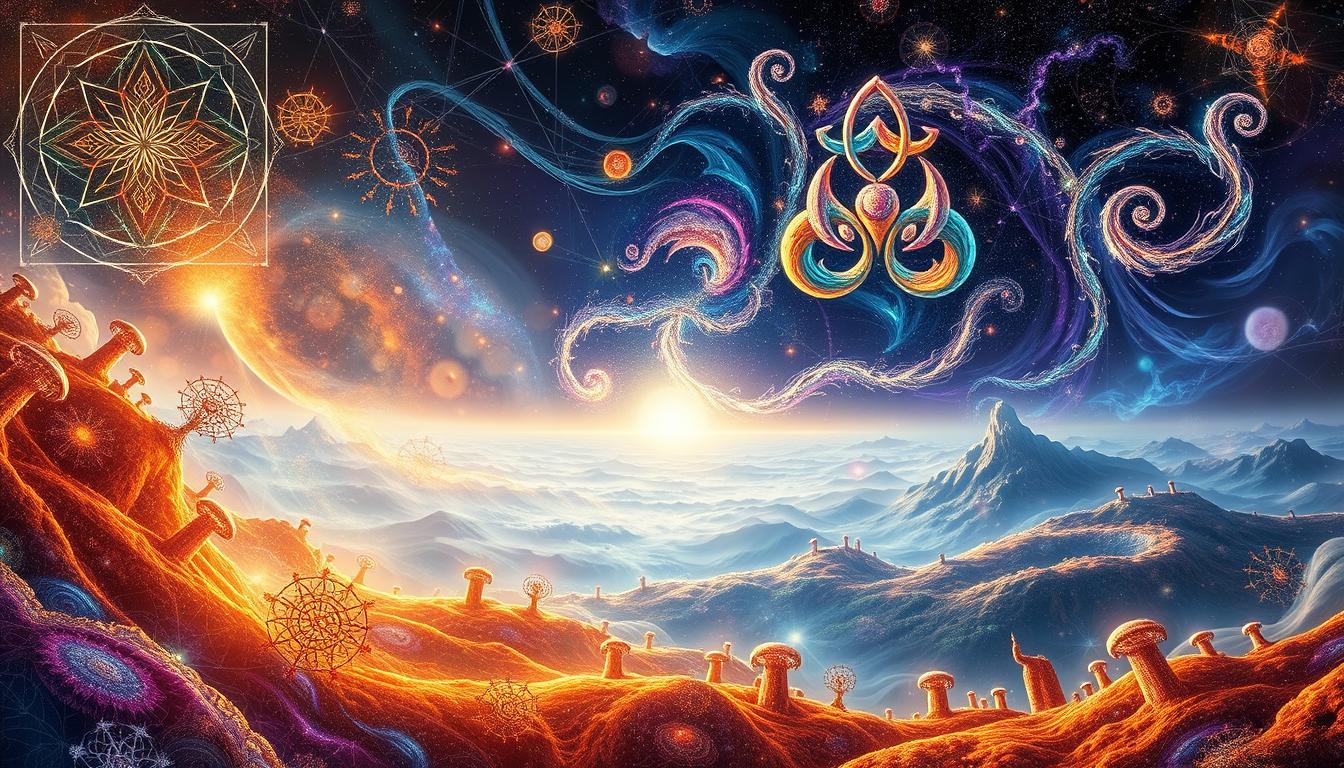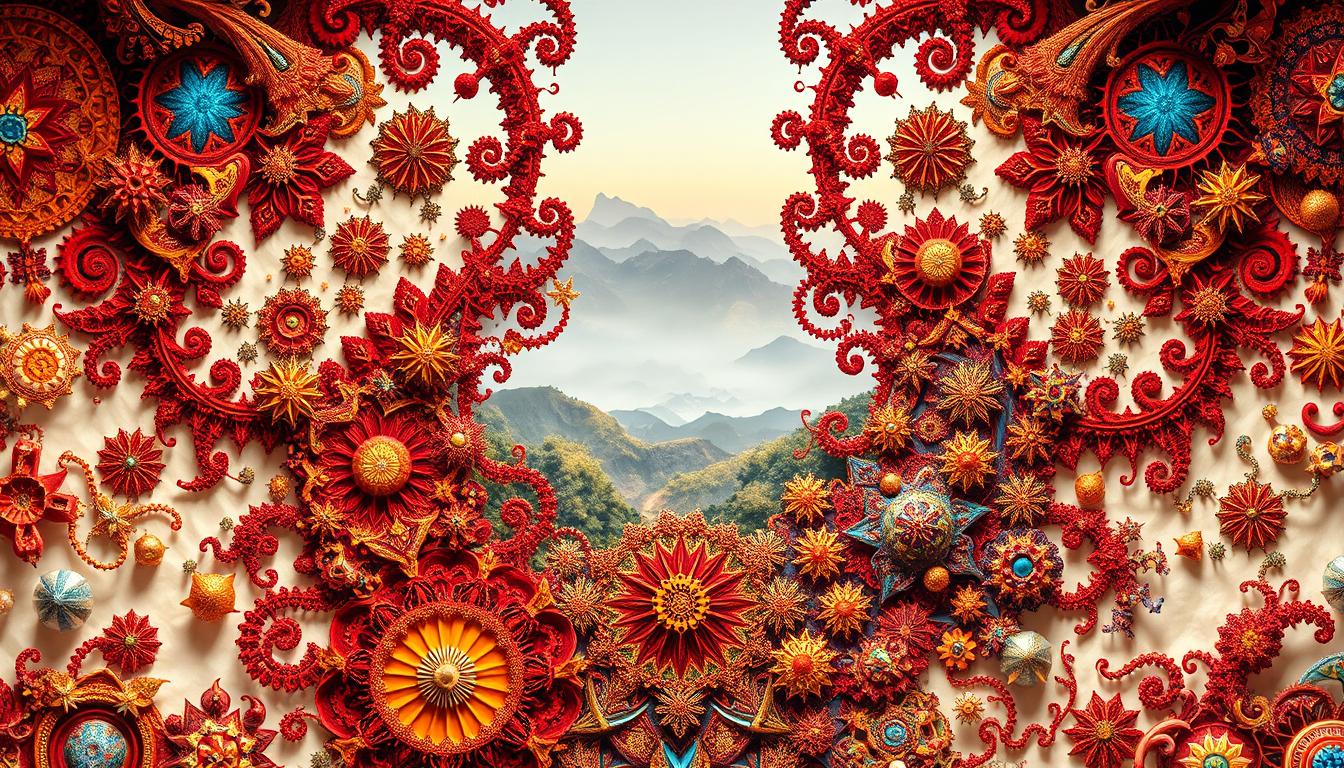Fractal symbolism weaves a rich tapestry into indigenous myths and legends. These complex patterns repeat across various scales. They act as deep metaphors, showing cultural insights and philosophies.
As we explore fractal patterns, we’ll see how they shape stories in indigenous societies’ histories. Through nature’s geometry, we’ll understand their role in showing cultural values and beliefs. Join us on this journey to discover how fractal symbolism and myths connect through generations.
The Concept of Fractals in Nature
Fractals are a cool way of seeing math in the world around us. They’re complex shapes that repeat smaller versions of themselves. You can spot these patterns in trees, clouds, and coastlines. These things show the amazing geometric patterns that look like bigger versions of themselves.
The idea of self-similarity is key in fractals. It shows how nature makes repeating patterns, no matter the size. For example, a tree branch looks a lot like a whole tree. This shows the beautiful geometry in nature. Through these shapes, we see the intricacy of nature and how things grow and change.
Studying nature’s fractals helps us understand how ecosystems work and change. These patterns reveal the math that rules many natural things. Researchers find out more about the world and cultures that value these patterns. Fractals and nature together lead us to learn more about how people see and connect with the world around them.

Understanding Indigenous Myths and Their Cultural Significance
Indigenous myths are deeply woven into the culture of many societies. They capture the beliefs, values, and history of different peoples. Through these stories, people connect with nature, the universe, and each other.
Indigenous storytelling reveals a deep knowledge of the world and human life. These stories are more than just tales. They are crucial to preserving the identity and knowledge of communities over time. Indigenous myths are key to understanding traditions that shape how communities and individuals see themselves.
These stories often share moral lessons, explain nature, and celebrate the bond between humans and the earth. They link the past to the present, helping to keep cultural identity alive. The ongoing value of these myths highlights why it’s important to respect and learn from them.
Fractal Symbolism in Indigenous Myths and Legends
In stories from indigenous cultures globally, fractal symbolism is key. These fractals stand for ideas like unity, ongoing life, and nature’s cycles. Through tales, these concepts come alive, showing how fractal patterns touch hearts across cultures. Diving into these tales from various cultures sheds light on fractal patterns’ deep meanings.
How Fractals are Interpreted in Various Cultures
In native cultures, fractals show up as natural shapes, hinting at how the environment impacts spiritual views. Examples include spirals in seashells and tree branches, representing life and growth. These symbols weave through their stories, linking people to the earth.
Examples of Fractal Patterns in Indigenous Art and Artifacts
Indigenous art, like textiles, carvings, and pottery, often bears fractal designs. These pieces reflect the fractals in nature around them. Through art, they tell stories and keep their culture’s values and beliefs alive.
The Influence of Colonialism on Indigenous Symbolism
Colonialism has changed indigenous symbolism a lot. As they spread their influence, colonial powers introduced new beliefs. These often overshadowed or even replaced traditional cultural expressions. This change affects how symbols are seen and used. It separates them from their original meanings and uses. This has a big impact on cultural identity, especially for communities trying to keep their heritage alive.
The Effects of Displacement on Cultural Constructs
Cultural displacement breaks the chain of traditional stories. This leaves symbols broken and often wrongly shown. The impacts of colonial actions show in many ways, including:
- Erasure of local customs and practices
- Redefinition of what cultural artifacts mean
- Creation of new, sometimes mixed identities through forced influences
This leads to a complex situation. Indigenous symbols can easily be misunderstood. Getting these symbols back to their original place in cultural stories needs a lot of work. This work includes reclaiming them and showing their real contexts.
Case Study: Hindu Temples and Their Fractal Designs
Hindu temples are a key example of how colonialism affects indigenous symbolism. The complex fractal designs in these buildings have deep spiritual and cultural importance. They show a special understanding of the universe. But colonial practices have made us forget these original meanings. Now, the fractal designs might just be seen as parts of the building. They’re cut off from their deep cultural roots.
This case study points out the bigger issue of cultural displacement. It shows why we need to know and teach the stories behind these symbols. Working to fix the damage done by colonialism is key. Understanding the value of indigenous symbols is vital for bringing back cultural strength and identity.
Exploring African Fractal Geometry
African fractal geometry is key in showing cultural identity across communities. These patterns do more than just look pretty; they illustrate a deep connection between shape and purpose in local designs. Dr. Ron Eglash’s work highlights how these patterns are found all over Africa.
The Role of Fractals in African Cultural Identity
Fractals are everywhere in African culture, from buildings to art. They act as emblems of identity and a sense of belonging. Through repeated designs, they link to the spiritual and community life. These patterns help share stories and customs, making the culture of African groups stronger.
Dr. Ron Eglash’s studies reveal the impact of fractal geometry in traditional designs. He has shown that these patterns shape everything from hairstyles to homes. Eglash argues against the view that local cultures lack advanced math skills. His work proves that African traditions have a rich and complex grasp of mathematics.
Applications of Fractal Geometry in Indigenous Practices
Fractal geometry in indigenous practices shows a deep bond with nature and culture. These communities use geometric ideas in life areas like farming and social setups. For example, farm designs often copy nature’s fractal patterns, boosting output and sustainability. This method makes land use efficient, reducing waste and increasing harvest.
Besides agriculture, fractal designs are in community planning. They create spaces that encourage people to interact, reflecting the unity in many indigenous cultures. Fractal geometry isn’t just practical; it carries important cultural stories. It strengthens identity and unity among community members.
These practices also spotlight sustainability. Many indigenous methods based on fractal geometry care for the environment. They align human efforts with nature. By using these principles, communities boost their wellbeing and honor their heritage. Studies prove fractal patterns’ role in moving towards sustainable practices while keeping cultural values.
Fractal Patterns in Indigenous Architecture
Fractal architecture is a key way Indigenous people show their values through design. It shows the rich similarities and differences between Native American and African buildings. These designs prove how important fractals are to these cultures.
Comparative Analysis of Native American and African Indigenous Structures
Native American and African buildings both greatly feature fractal geometry. This creates stunning visual designs and communicates deep cultural stories. Different structures in these regions use fractals to cater to cultural and environmental needs.
- Native American structures often utilize concentric arrangements and repeating geometric shapes, symbolizing harmony and balance with nature.
- African architecture showcases intricate designs where fractal patterns reflect the community’s connection to ancestral heritage and social cohesion.
Looking at the architectural details of each tradition reveals important aspects.
- Design Elements: Native American homes, like tipis and pueblos, show spiraling and radiating patterns. African buildings, meanwhile, use zigzags and complex designs.
- Layout: Both styles focus on community, designing spaces for people to connect, all based on fractal ideas.
- Cultural Functionality: Both architectural styles are sustainable, using local materials and efficient designs encouraged by fractal concepts.
This comparison shows how fractal architecture tells stories visually. It captures the heart of Native American and African cultures.
The Intersect of Fractal Patterns and Mythology
Fractal patterns are found in many cultural stories. They show a deep link between math and mythology. These patterns mirror themes in old myths, like time and life’s cycle.
In different cultures, fractals help explain life and the world around us. Myths with cycles show life’s repeating nature, just like fractals. By looking closely at these stories, we learn more about cultures and what they value.
Mythology has two main uses. It entertains us and keeps cultural history alive through fractal patterns. The mix of fractals and myths shows how deeply people think. It connects the physical world to deeper meanings.
Conclusion
Looking into fractal symbolism and indigenous myths reveals deep cultural insights. These patterns show how deeply they affect various societies. We’ve seen how fractals in nature and human creations are key in storytelling and art for indigenous people.
These shapes go beyond just looking nice. They reflect deep thoughts on life, spirituality, and our universe connection. Fractals in indigenous practices tie communities to their history and nature.
By exploring fractal complexities, we learn from indigenous myths and their symbolism. This shows the value of linking math, art, and stories in these traditions. It asks us to value these crossroads more.
Ending our look at fractal symbolism, we understand its role in indigenous myths better. It sparks more respect for cultures that see nature, art, and storytelling as closely linked. This bond strengthens our identities, showing us how connected our world is.



